Miso Salmon Bites
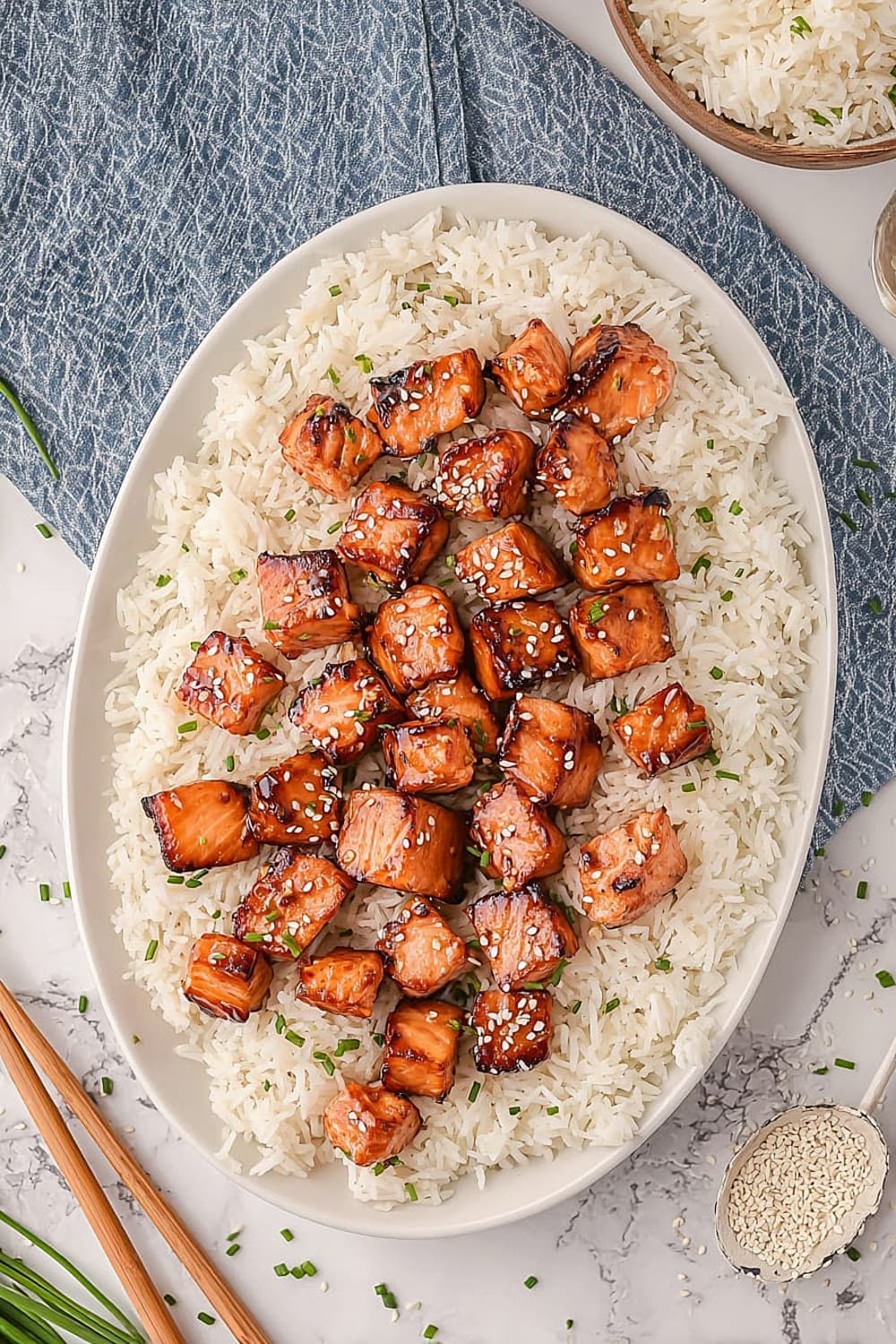
These little flavor bombs are about to become your secret weapon for looking like you actually know what you’re doing in the kitchen.
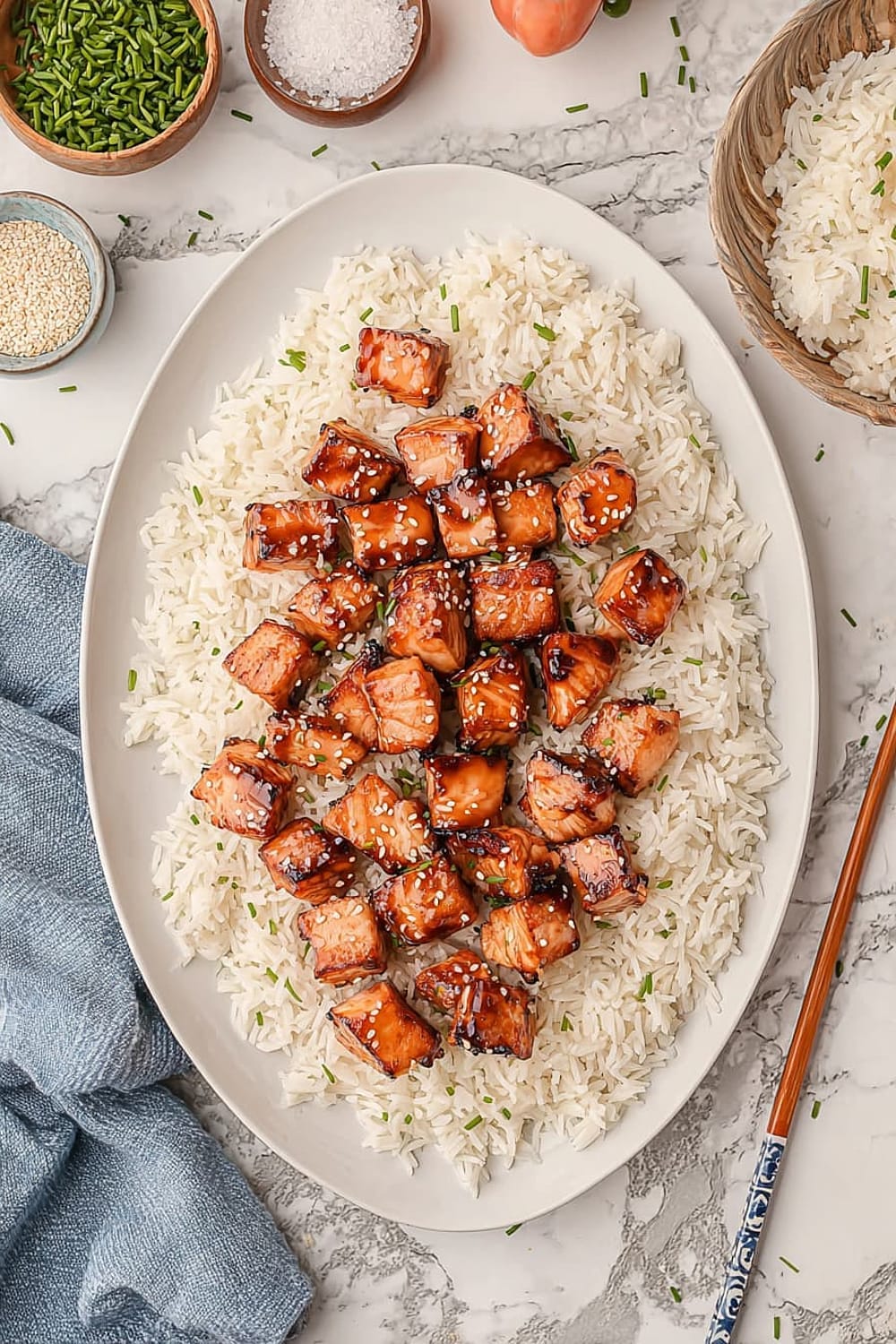
The umami-rich miso glaze transforms ordinary salmon into restaurant-quality bites that’ll have people asking for your “recipe secrets.”
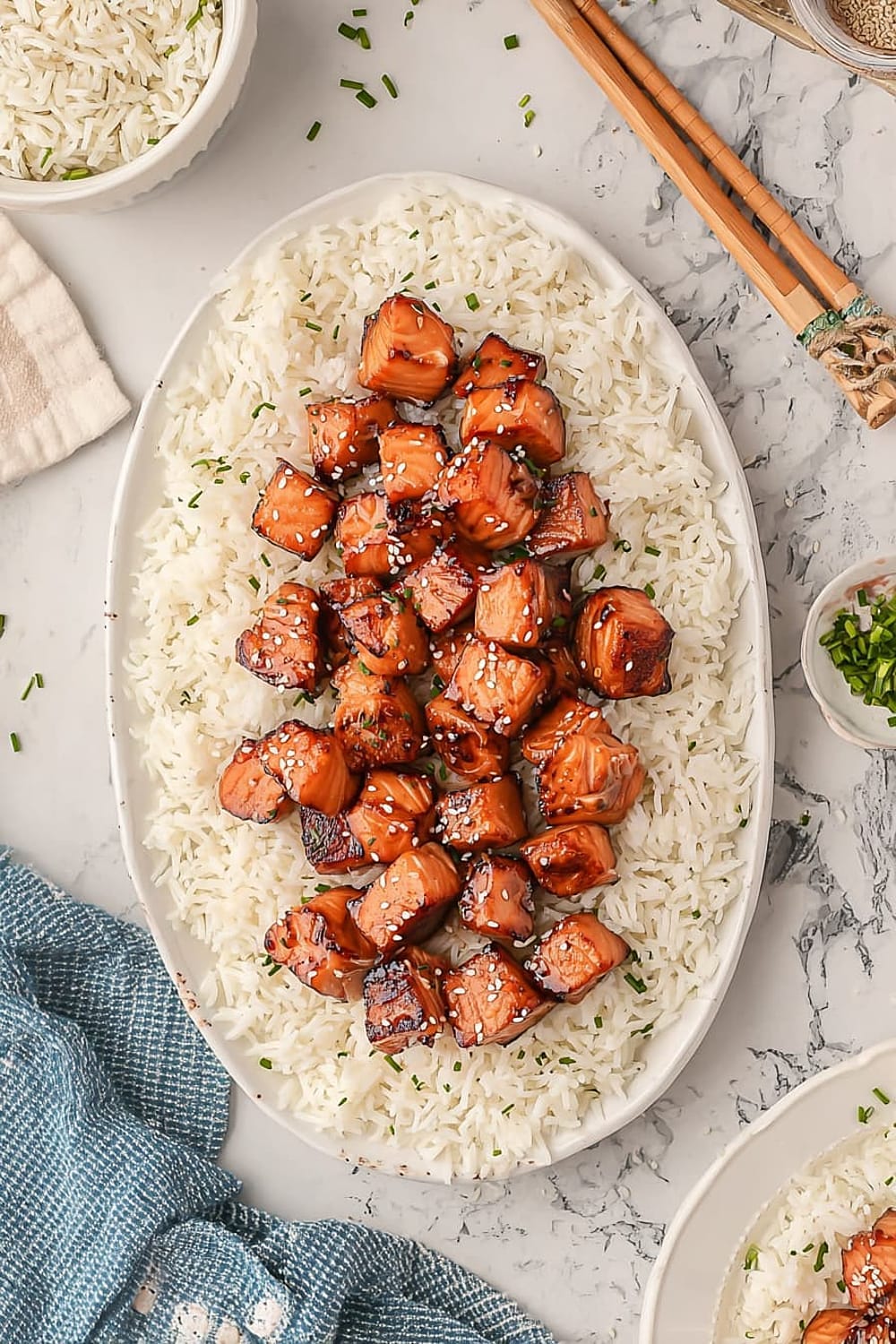
What makes these so genius is how the high heat creates perfectly caramelized edges while keeping the center buttery and flaky.
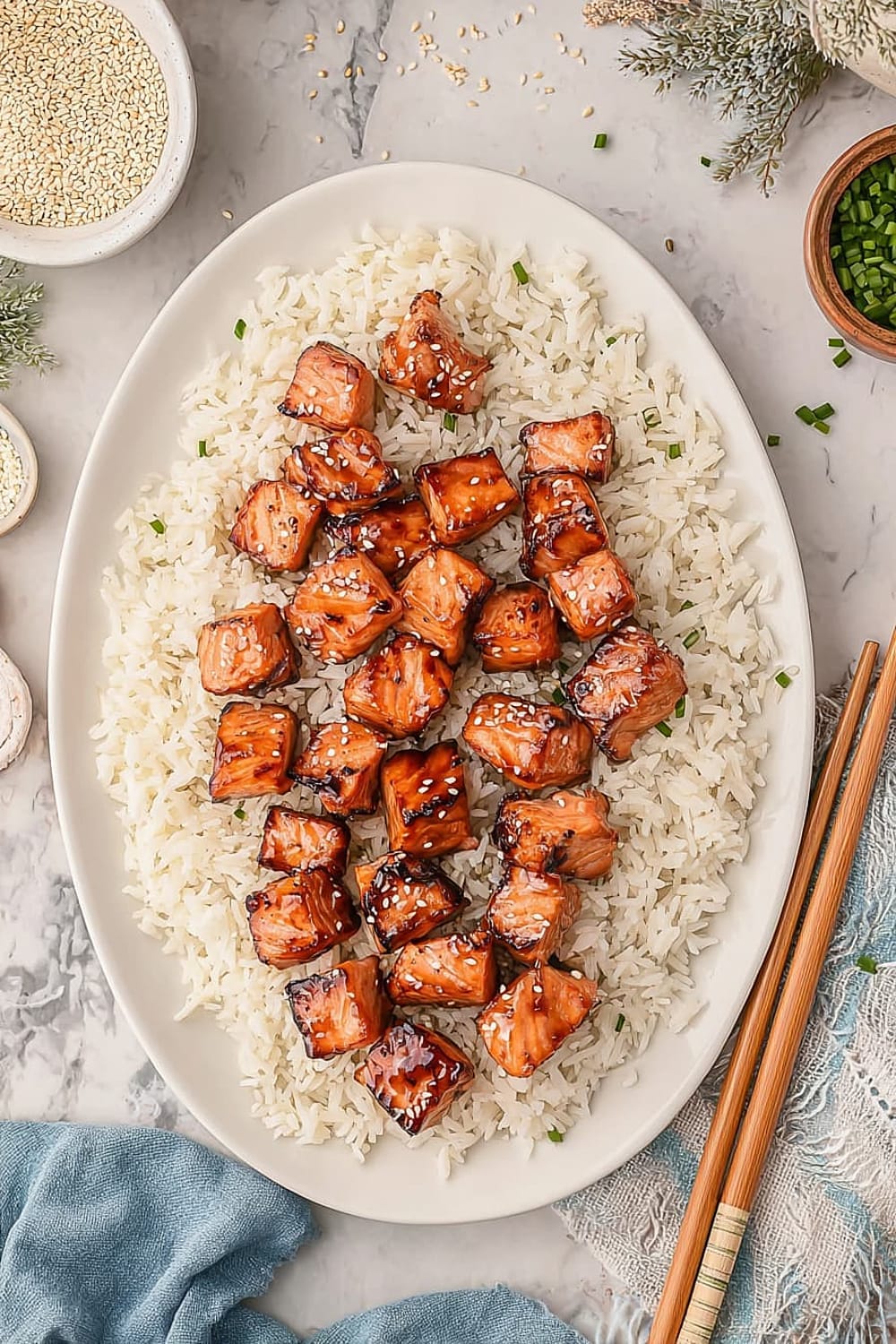
The sweet-salty-savory balance hits all the right notes, with that distinctive miso depth that makes your taste buds do a happy dance.
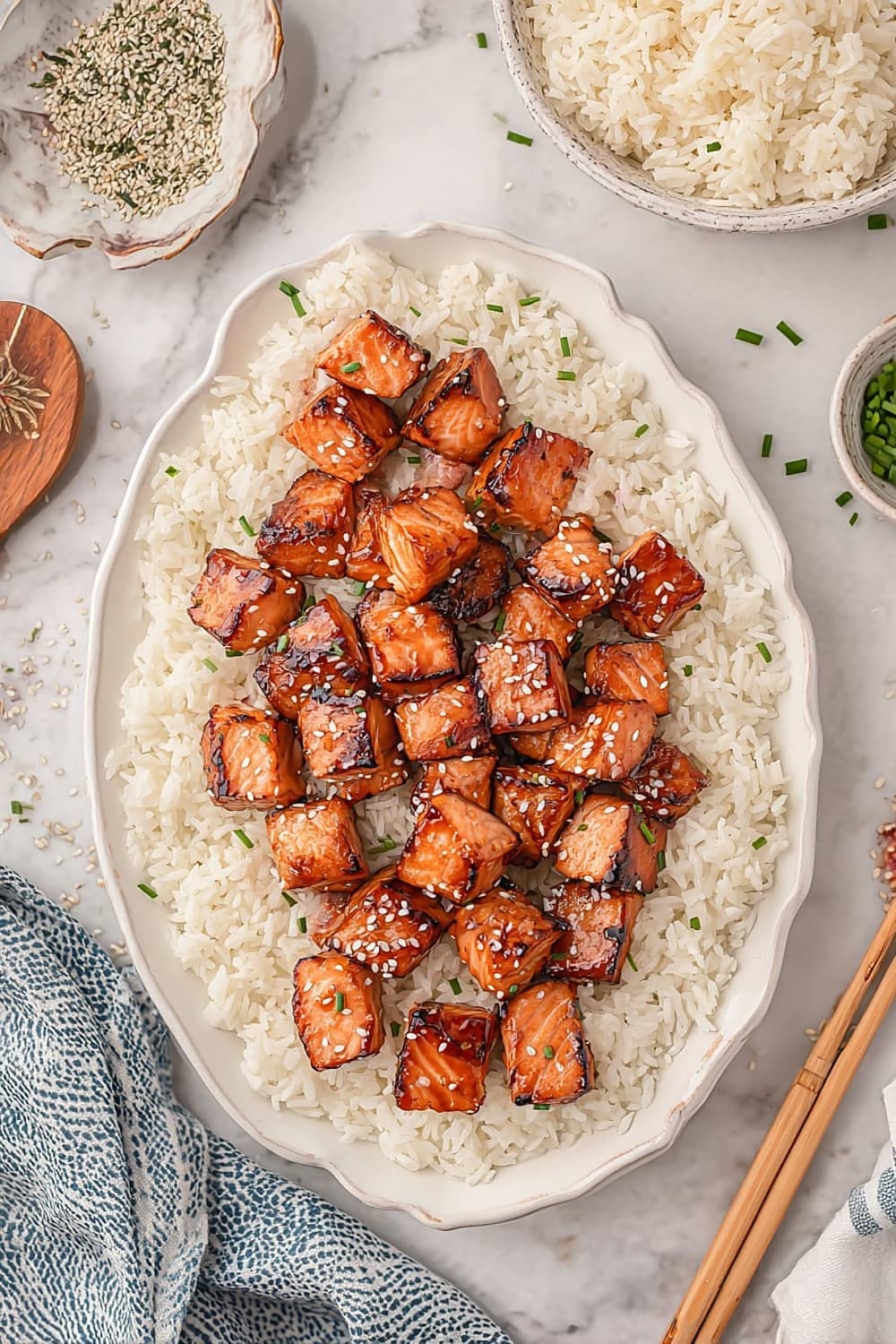
Plus, they’re ready in under 20 minutes total, which means you can go from “what’s for dinner” panic to “I’m basically a culinary mastermind” in record time.
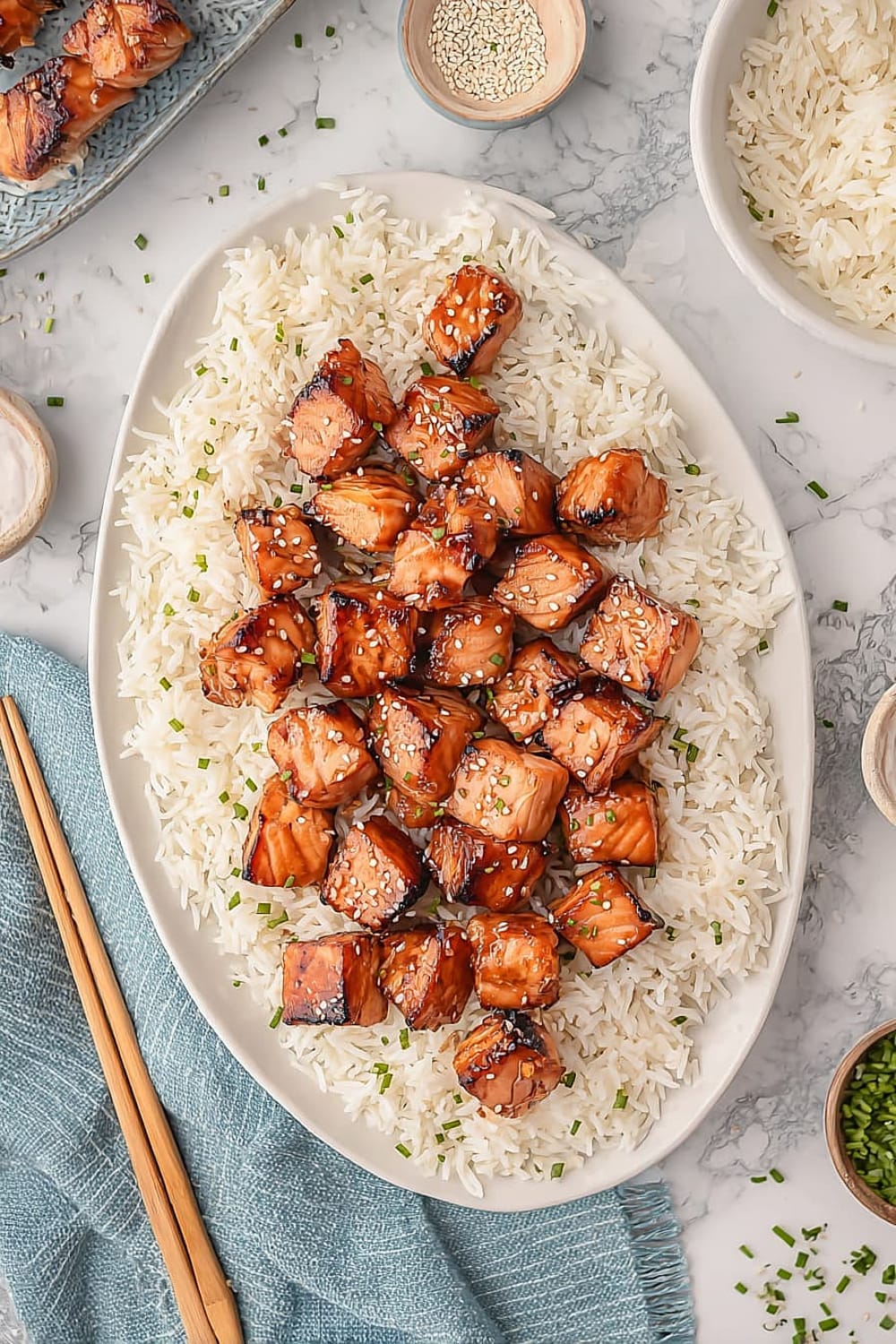
Warning: making these will result in people assuming you’re way more sophisticated than you actually are, so just roll with it.
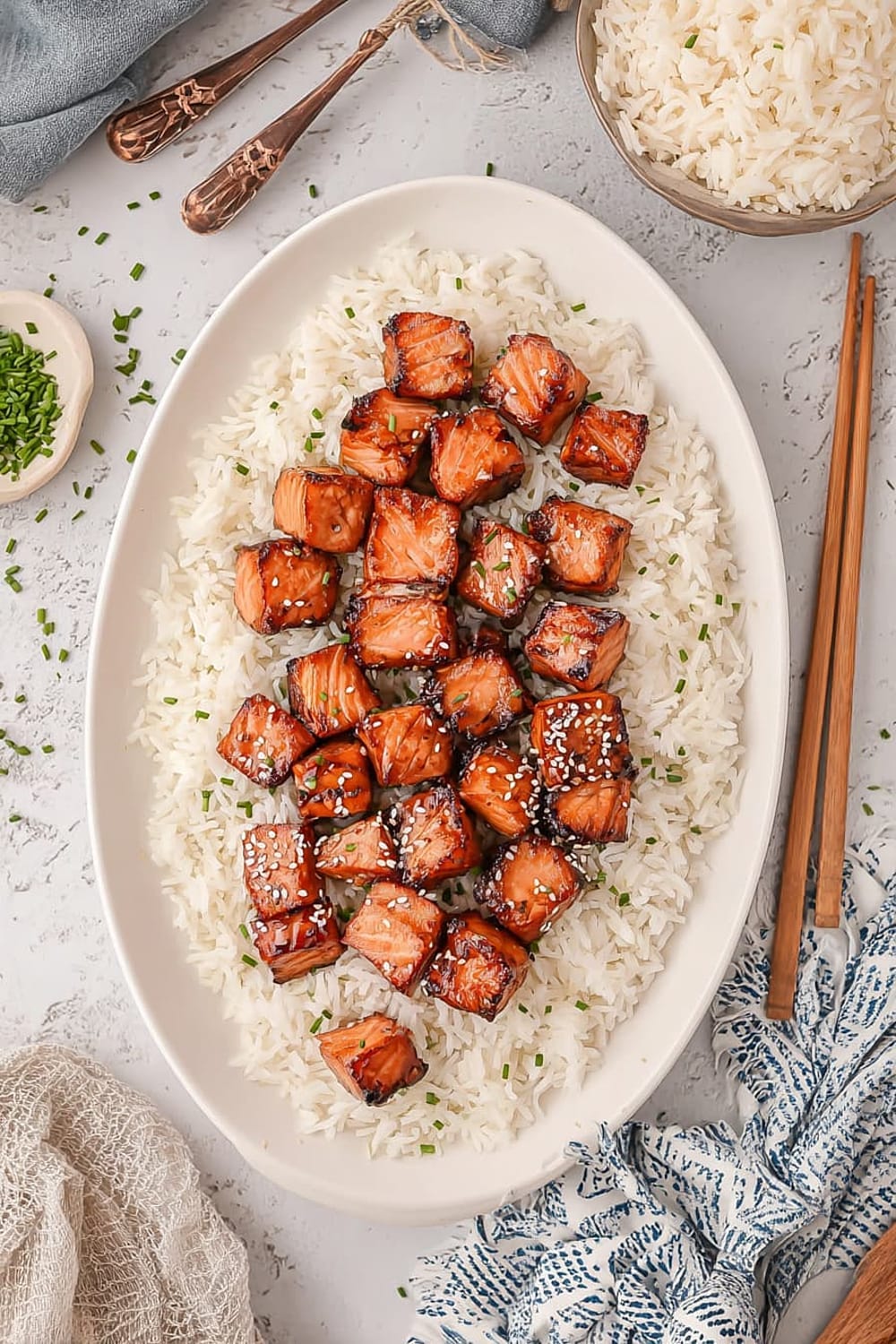
Ingredients
For the Salmon
- 18 oz skinless salmon (about three 6oz fillets)
For the Miso Glaze
- 2 tbsp rice vinegar
- 1 tbsp soy sauce
- 1 tbsp miso paste (red or white – red adds deeper flavor)
- 1 tsp honey
- ½ tsp sesame oil
- ½ tsp ground ginger
- ½ tsp garlic powder
Instructions
Preparation
- 1 Preheat your oven to 475°F (246°C) and line a baking sheet with parchment paper. This high temperature is crucial for getting those beautiful caramelized edges without overcooking the salmon.
- 2 Cut the salmon into bite-sized pieces, roughly 1-inch cubes, and place them in a large mixing bowl. Try to keep pieces uniform in size so they cook evenly – nobody wants some pieces perfectly done while others are still raw or overcooked.
Make the Glaze
- 3 In a separate bowl, whisk together the rice vinegar, soy sauce, miso paste, honey, sesame oil, ground ginger, and garlic powder. Keep whisking until the miso paste is completely dissolved and the mixture is smooth – any lumps will create uneven flavor distribution.
- 4 The glaze should have a glossy, slightly thick consistency that coats the back of a spoon. If your miso paste seems stubborn, try mashing it against the side of the bowl with your whisk to break it down completely.
Assemble and Bake
- 5 Pour the miso mixture over the salmon cubes and gently toss to coat every piece thoroughly. Use your hands or a large spoon to ensure each bite gets maximum flavor coverage.
- 6 Arrange the glazed salmon pieces on the prepared baking sheet in a single layer, leaving space between each piece. Brush any remaining marinade from the bowl over the tops – this extra glaze will caramelize beautifully in the oven.
- 7 Bake for 5-6 minutes only. The salmon should be just cooked through with slightly firm edges and a tender, flaky center. Overcooking will result in dry, tough bites, so watch carefully during the final minute.
- 8 Remove from oven immediately and serve while hot. The residual heat will continue cooking the salmon slightly, so don’t let them sit on the hot pan too long.
Recommended Equipment and Kitchen Tools
Essential Tools (for best results)
- Sharp chef’s knife – Clean cuts through salmon prevent tearing and ensure even cooking
- Large mixing bowls – Separate bowls for salmon and glaze prevent cross-contamination and make coating easier
- Wire whisk – Essential for breaking down miso paste and creating a smooth, lump-free glaze
- Rimmed baking sheet – Prevents any glaze from dripping into your oven and burning
Helpful Upgrades
- Kitchen scale – Measuring salmon by weight ensures consistent portion sizes and cooking times
- Silicone brush – Perfect for applying that final glaze coating without tearing delicate fish
- Instant-read thermometer – Takes the guesswork out of doneness (salmon is perfect at 145°F/63°C internal temperature)
Nice-to-Have Options
- Parchment paper – Makes cleanup effortless and prevents sticking better than cooking spray
- Microplane grater – If you want to upgrade to fresh ginger instead of ground, this makes quick work of grating
Recipe Variations and Dietary Modifications
Gluten-Free Adaptation
- Replace soy sauce with tamari or coconut aminos using the same 1 tablespoon measurement
- Ensure your miso paste is certified gluten-free, as some varieties contain barley
- All other ingredients are naturally gluten-free
Flavor Variations
- Spicy version: Add ½ teaspoon sriracha or ¼ teaspoon red pepper flakes to the glaze
- Citrus twist: Replace rice vinegar with fresh lime juice and add 1 teaspoon lime zest
- Maple miso: Substitute honey with pure maple syrup for deeper sweetness
- Herb-crusted: Sprinkle sesame seeds and chopped green onions on top before baking
Cooking Method Alternatives
- Air fryer: Cook at 400°F (204°C) for 4-5 minutes, shaking basket halfway through
- Broiler method: Broil on high for 3-4 minutes, watching carefully to prevent burning
- Pan-seared: Cook in a hot skillet with oil for 2-3 minutes per side
Protein Swaps
- Firm tofu cubes: Press well and marinate for 15 minutes before baking
- Chicken thighs: Cut into cubes and increase cooking time to 8-10 minutes
Nutritional Information and Health Benefits
Key Nutritional Highlights
Each serving provides approximately 280 calories with 35g high-quality protein, 2g carbohydrates, and 14g healthy fats. This recipe delivers an excellent protein-to-calorie ratio, making it perfect for muscle maintenance and satiety.
Health Benefits of Main Ingredients
Salmon provides omega-3 fatty acids EPA and DHA, which support heart health, brain function, and reduce inflammation. The miso paste contains beneficial probiotics that support digestive health and adds B vitamins and minerals like zinc and manganese. Sesame oil contributes vitamin E and lignans with antioxidant properties, while ginger offers anti-inflammatory compounds called gingerols.
Dietary Considerations
This recipe is naturally low-carb, keto-friendly, and dairy-free. It contains fish, soy, and sesame, so avoid if you have allergies to these ingredients. The high protein content makes it excellent for post-workout meals or anyone following a higher-protein eating pattern. One serving provides about 70% of daily omega-3 needs and 25% of daily selenium requirements.
Smart Swaps and Ingredient Substitutions
Common Substitutions:
- Miso paste → 2 tablespoons soy sauce + 1 teaspoon brown sugar (reduces umami depth but works in a pinch)
- Rice vinegar → Apple cider vinegar or white wine vinegar (use same amount)
- Sesame oil → Olive oil (flavor will be different but still delicious)
- Honey → Brown sugar, maple syrup, or agave (use same measurement)
Budget-Friendly Swaps:
- Fresh salmon → Frozen salmon fillets (thaw completely and pat very dry before cutting)
- Individual fillets → Whole salmon side (often cheaper per pound, cut into portions)
- White miso → Red miso (red is typically less expensive and adds deeper flavor)
Pantry Emergency Substitutions:
- Ground ginger → 1 tablespoon fresh grated ginger (much more potent flavor)
- Garlic powder → 2 fresh garlic cloves, minced (add to glaze and let sit 10 minutes)
- No miso paste → 1 tablespoon soy sauce + 1 teaspoon anchovy paste + pinch of sugar
Pro Tips for Substitutions:
- Store leftover miso paste in the refrigerator for up to 6 months – it’s worth buying for future recipes
- When using fresh ginger or garlic, let the glaze sit for 10 minutes to develop flavors before coating salmon
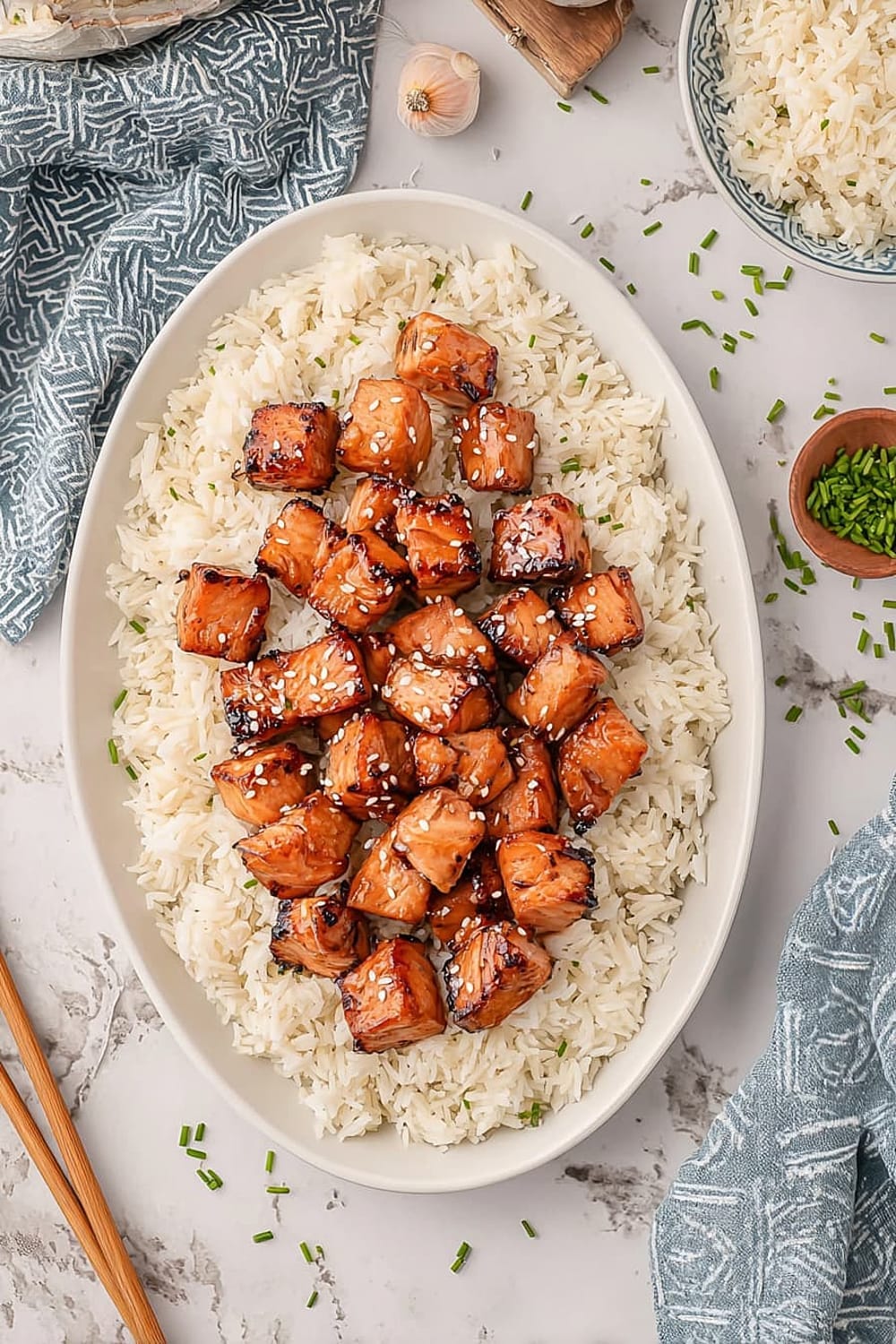
Make It Diabetes-Friendly
Carb Content Analysis:
- Current carbs per serving: Approximately 2g total carbs, 1g net carbs
- Honey substitution: Replace honey with stevia or monk fruit sweetener (start with ¼ teaspoon and adjust to taste)
- Sugar-free option: Use sugar-free maple syrup for similar flavor profile
Blood Sugar Considerations:
- High protein content (35g per serving) helps stabilize blood sugar response
- Healthy fats from salmon slow glucose absorption
- Minimal carbohydrates make this naturally diabetes-friendly
Portion & Timing Tips:
- Recommended serving: 6 oz salmon (about ⅓ of recipe) provides filling protein without blood sugar spikes
- Pair with: Non-starchy vegetables like roasted broccoli or cauliflower rice
- Meal timing: Excellent for lunch or dinner when paired with fiber-rich vegetables
Enhanced Diabetes Benefits:
- Omega-3 fatty acids may improve insulin sensitivity
- High protein helps maintain steady energy levels
- Anti-inflammatory ingredients support overall metabolic health

Perfect Pairing Suggestions
Beverage Pairings
Wine: Crisp Sauvignon Blanc or Pinot Grigio complements the salty-sweet glaze without overwhelming the delicate salmon. For red wine lovers, try a light Pinot Noir. Beer: Japanese lagers or wheat beers echo the Asian flavor profile beautifully. Non-alcoholic: Sparkling water with lime or unsweetened iced green tea cleanse the palate between bites.
Side Dish Recommendations
Steamed jasmine rice or cauliflower rice absorbs any extra glaze perfectly. Roasted asparagus or broccolini add fresh, crisp contrast to the rich salmon. Asian cucumber salad with rice vinegar provides cooling balance. Edamame continues the Japanese theme while adding fiber and plant protein.
Complete Meal Ideas
Start with miso soup or seaweed salad as appetizers. Serve salmon bites over mixed greens with avocado and shredded carrots for a complete bowl. For entertaining, arrange on small plates with pickled vegetables and wasabi mayo for dipping.
Occasion Suggestions
Perfect for cocktail parties as elegant finger food, weeknight dinners when time is short, or meal prep since they reheat beautifully. Great for date nights when you want to impress without stress, or family dinners where even picky eaters will approve.
Pro Tips and Troubleshooting
Professional Techniques
Pat salmon completely dry before cutting – moisture prevents proper caramelization and creates steam instead of that coveted crispy exterior. Cut against the grain when possible to ensure tender bites. Let the glaze sit on salmon for 2-3 minutes before baking to allow flavors to penetrate.
Common Mistakes and Solutions
Overcooking is the biggest culprit – salmon continues cooking from residual heat, so remove when it’s just barely opaque in the center. Uneven pieces cook at different rates, so take time to cut uniform cubes. Soggy bottoms happen when baking sheets are overcrowded – leave space between pieces for proper air circulation.
Storage and Reheating
Refrigerate leftovers up to 3 days in airtight containers. Reheat gently in a 300°F (149°C) oven for 5-7 minutes or microwave on 50% power in 30-second intervals. Avoid high heat reheating which makes salmon rubbery.
Make-Ahead Strategies
Prepare glaze up to 2 days ahead and store refrigerated. Cut salmon the morning of cooking and keep chilled. Don’t marinate longer than 30 minutes as the acid will start “cooking” the fish.
Scaling Tips
Double recipe easily using two baking sheets. For larger crowds, consider making different flavor variations. Recipe halves perfectly for smaller households – just use one 6oz fillet.
This recipe proves that restaurant-quality flavors don’t require restaurant-level stress or skills. The combination of high heat, quality ingredients, and perfect timing creates salmon bites that taste like you spent hours in the kitchen when you really spent minutes. Whether you’re impressing guests or just treating yourself to something special on a Tuesday night, these miso salmon bites deliver maximum impact with minimal effort. The umami-rich glaze paired with perfectly cooked salmon creates a dish that’s both sophisticated enough for entertaining and simple enough for regular rotation in your dinner lineup.